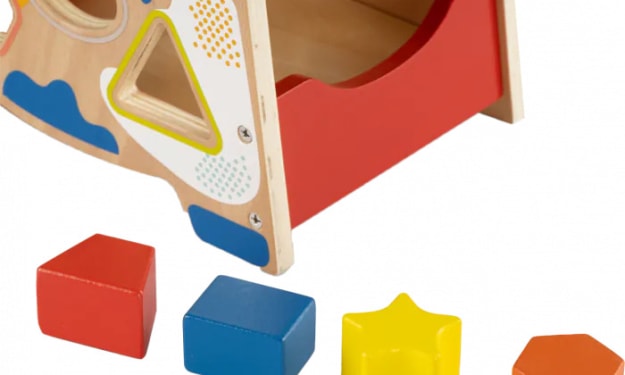The Magic of Early Years Toys
The Magic of Early Years Toys

Introduction
Early childhood is a critical period for growth and development. During these formative years, children are like sponges, absorbing information and experiences that shape their cognitive, emotional, and physical abilities. Toys play an essential role in this development, acting as tools for learning, creativity, and exploration. This blog delves into the fascinating world of early years toys, exploring their history, types, benefits, and how they contribute to a child's growth.
A Brief History of Early Years Toys
The history of toys dates back to ancient civilizations. Archaeologists have discovered evidence of toys from as early as 3000 BCE in ancient Mesopotamia, including miniature carts and dolls made of stone and clay. Ancient Egyptian children played with dolls made of wood, stone, and pottery, often adorned with wigs and movable limbs. In Greece and Rome, children played with a variety of toys, including rattles, hoops, and pull-along animals.
During the Middle Ages, toys were often handmade from wood and cloth. By the 19th century, the industrial revolution brought mass production of toys, making them more accessible to the general public. The 20th century saw a boom in toy innovation with the introduction of plastic, leading to iconic toys such as LEGO, Barbie dolls, and action figures.
The Role of Toys in Child Development
Toys are not merely objects for entertainment; they are instrumental in a child's development. They stimulate various aspects of growth, including cognitive, physical, social, and emotional development.
Cognitive Development
Cognitive development refers to how children think, explore, and figure things out. It encompasses problem-solving, memory, and decision-making. Toys that challenge a child's mind, such as puzzles, building blocks, and educational games, are crucial for cognitive growth. These toys encourage children to think critically, recognize patterns, and develop spatial awareness.
Physical Development
Physical development involves the growth and strengthening of a child's body and motor skills. Toys like balls, bicycles, and climbing structures promote gross motor skills, helping children develop balance, coordination, and strength. Fine motor skills, which involve the use of smaller muscle groups, are enhanced by toys such as threading beads, drawing tools, and building sets.
Social and Emotional Development
Social and emotional development is about how children understand themselves and interact with others. Role-playing toys, such as dolls, action figures, and play kitchens, allow children to explore different social roles and practice empathy. Board games and group activities teach cooperation, sharing, and communication skills. Emotional intelligence is nurtured when children express their feelings and experiences through play.
Types of Early Years Toys
Early years toys come in various forms, each serving a unique purpose in a child's development. Here, we categorize and explore different types of toys and their benefits.
Sensory Toys
Sensory toys are designed to stimulate a child's senses: sight, sound, touch, taste, and smell. These toys are particularly beneficial for infants and toddlers as they explore their environment.
1. Rattles and Mobiles: These toys capture a child's attention with their sounds and movement, encouraging visual tracking and auditory skills.
2. Textured Toys: Soft toys with varied textures help babies develop their sense of touch and dexterity.
3. Musical Toys: Instruments like drums, xylophones, and shakers introduce children to the world of music and rhythm, enhancing auditory development and coordination.
Constructive Toys
Constructive toys, also known as building toys, allow children to create and manipulate objects. They are excellent for developing fine motor skills, hand-eye coordination, and spatial awareness.
1. Building Blocks: Wooden blocks, LEGO, and other construction sets encourage creativity and problem-solving. Children learn about balance, symmetry, and engineering concepts.
2. Shape Sorters and Stackers: These toys help toddlers recognize shapes and colors while improving their fine motor skills and hand-eye coordination.
Role-Playing Toys
Role-playing toys enable children to imitate real-life scenarios, fostering imagination and social skills.
1. Dolls and Action Figures: Playing with dolls and action figures helps children understand social roles, develop empathy, and express their emotions.
2. Play Kitchens and Tool Sets: These toys encourage imaginative play and teach children about everyday tasks and responsibilities.
Educational Toys
Educational toys are designed to teach specific skills or concepts, such as numbers, letters, and problem-solving.
1. Alphabet and Number Toys: Puzzles, blocks, and games that feature letters and numbers introduce children to literacy and numeracy.
2. Science Kits and Experiments: These kits spark curiosity and introduce basic scientific concepts, encouraging children to explore and discover.
Outdoor Toys
Outdoor toys promote physical activity and exploration of the natural environment.
1. Bicycles and Tricycles: These toys help children develop balance, coordination, and strength while enjoying outdoor play.
2. Sand and Water Play: Sandboxes, water tables, and beach toys provide sensory experiences and encourage imaginative play.
Selecting the Right Toys
Choosing the right toys for a child can be overwhelming given the plethora of options available. Here are some tips to help parents and caregivers make informed decisions.
Age Appropriateness
Toys should be suitable for the child's age and developmental stage. Manufacturers typically provide age recommendations on toy packaging, which can serve as a useful guide.
• Infants (0-12 months): Look for toys that stimulate the senses, such as rattles, soft toys, and teething rings.
• Toddlers (1-3 years): Choose toys that promote physical activity and exploration, like ride-on toys, building blocks, and shape sorters.
• Preschoolers (3-5 years): Opt for toys that encourage creativity and problem-solving, such as art supplies, puzzles, and pretend play sets.
Safety
Safety is paramount when selecting toys for young children. Ensure that toys are made from non-toxic materials, have no small parts that could pose a choking hazard, and are sturdy enough to withstand rough play.
Educational Value
Consider toys that offer educational benefits and stimulate cognitive development. Look for toys that challenge the child's mind, introduce new concepts, and encourage learning through play.
Versatility
Versatile toys that can be used in multiple ways provide more value and extend the child's interest. Building blocks, for example, can be used to create endless structures, fostering creativity and imagination.
The Evolution of Toys in the Digital Age
The advent of technology has revolutionized the world of toys. Digital and electronic toys have become increasingly popular, offering interactive and immersive experiences.
Electronic Learning Toys
Electronic learning toys, such as tablets and interactive books, introduce children to digital literacy. These toys often come with educational apps and games that teach letters, numbers, and problem-solving skills.
Robotic Toys
Robotic toys, like programmable robots and drones, introduce children to the basics of coding and engineering. These toys encourage critical thinking and problem-solving as children learn to program and control their robotic creations.
Augmented Reality (AR) and Virtual Reality (VR) Toys
AR and VR toys provide immersive learning experiences, allowing children to explore virtual worlds and interact with digital objects. These toys can make learning more engaging and interactive, enhancing subjects like history, science, and geography.
Balancing Traditional and Digital Play
While digital toys offer unique learning opportunities, it is essential to balance them with traditional play. Hands-on, physical play is crucial for developing fine and gross motor skills, social interactions, and creativity.
Parents and caregivers should encourage a healthy mix of digital and traditional play, setting limits on screen time and promoting activities that involve physical movement, social interaction, and imaginative play.
Conclusion
Early years toys are more than just playthings; they are vital tools for development. From stimulating the senses to fostering creativity and critical thinking, toys play a crucial role in a child's growth. By understanding the types of toys and their benefits, parents and caregivers can make informed choices that support their child's development.
As technology continues to evolve, the world of toys will undoubtedly change. However, the fundamental role of play in a child's development remains constant. Whether traditional or digital, the best toys are those that engage, educate, and inspire, laying the foundation for a lifetime of learning and exploration.
#woodentoys #barnshenn #earlylearningtoys
About the Creator
Enjoyed the story? Support the Creator.
Subscribe for free to receive all their stories in your feed. You could also pledge your support or give them a one-off tip, letting them know you appreciate their work.





Comments (1)
Superbly written.